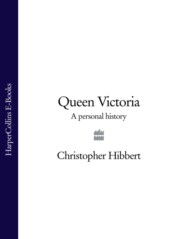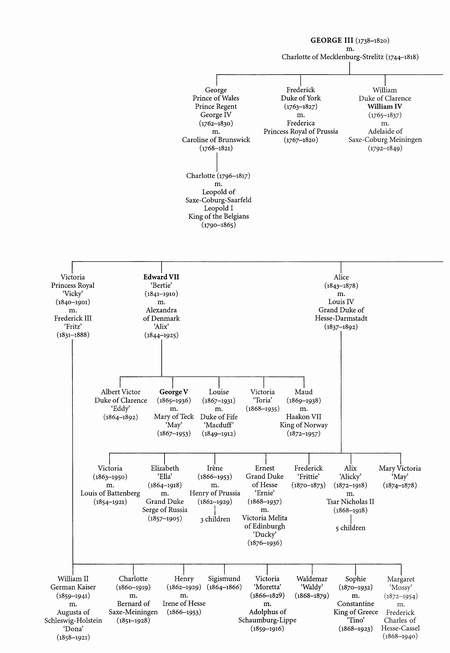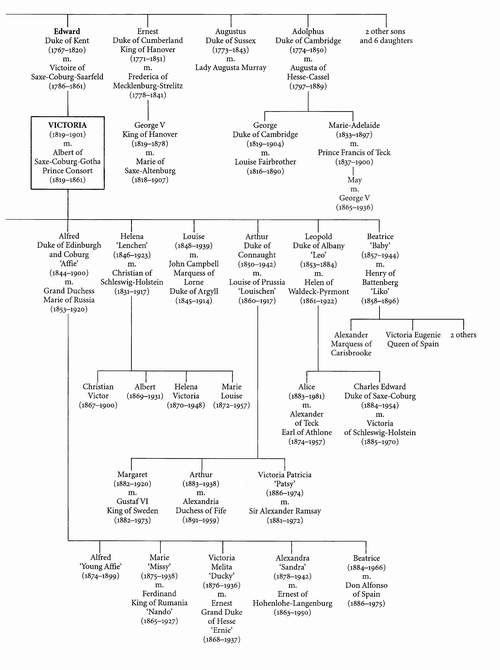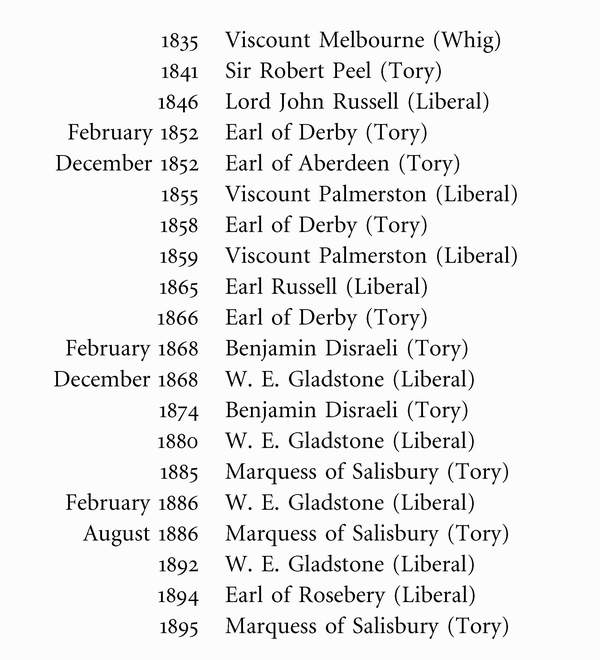
Полная версия:
Queen Victoria: A Personal History

Queen Victoria
A Personal History
Christopher Hibbert

For Amy, Lily and Rose with love
Table of Contents
Cover Page
Title Page
Dedication
ILLUSTRATIONS
AUTHOR’S NOTE AND ACKNOWLEDGEMENTS
VICTORIA’S FAMILY TREE
QUEEN VICTORIA’S PRIME MINISTERS
PART ONE 1819–1861
1 THE FAMILY
2 THE PARENTS
3 THE CHILD
4 CONROY
5 PROGRESSES
6 UNCLES
7 THE YOUNG QUEEN
8 MELBOURNE
9 CORONATION
10 THE HASTINGS AFFAIR
11 ‘A PLEASANT LIFE’
12 ‘A HEADSTRONG GIRL’
13 GERMAN COUSINS
14 PRINCE ALBERT
15 THE BRIDEGROOM
16 HONEYMOON
17 ROBERT PEEL
18 THE PRINCE AND THE HOUSEHOLD
19 ROYAL QUARRELS
20 OSBORNE
21 TRAVELLING
22 BALMORAL
23 THE PRINCE OF WALES
24 PALMERSTON
25 CHARTISTS
26 ‘PAM IS OUT’
27 THE GREAT EXHIBITION
28 ‘SCENES’
29 CRIMEAN WAR
30 NAPOLEON III
31 THE PRINCESS ROYAL
32 INDIAN MUTINY
33 THE GERMAN GRANDSON
34 DEATH OF THE DUCHESS
35 THE DISAPPOINTING HEIR
36 DEATH OF THE PRINCE
PART TWO 1861–1901
37 THE GRIEVING WIDOW
38 SEANCES AND SERVICES
39 PRINCESS ALEXANDRA
40 THE RECLUSE
41 DISRAELI
42 JOHN BROWN
43 ‘THE ROYALTY QUESTION’
44 ‘THE PRINCELY PAUPER’
45 TYPHOID FEVER
46 MAIDS-OF-HONOUR
47 SECRETARIES AND MINISTERS
48 REGINA ET IMPERATRIX
49 ‘THE HALF-MAD FIREBRAND’
50 GOLDEN JUBILEE
51 DIE ENGLÄNDERIN
52 THE DAUGHTERS
53 THE SONS
54 THE GRANDCHILDREN
55 WOULD-BE ASSASSINS
56 HOLIDAYS ABROAD
57 DEATH OF BROWN
58 THE MUNSHI
59 DIAMOND JUBILEE
60 LIFE AT COURT
61 DINNER PARTIES
62 BOOKS
63 BOOKMEN
64 FAILING HEALTH
65 DEATH
66 FUNERAL AND BURIAL
REFERENCES
SOURCES
INDEX
By the same author
Copyright
About the Publisher
ILLUSTRATIONS
COLOUR
Princess Victoria aged two with her mother, by Sir William Beechey. © Mary Evans Picture Library.
Princess Victoria aged four, by Stephen Poyntz Denning. By permission of the Trustees of Dulwich Picture Gallery.
Princess Victoria with her spaniel, ‘Dash’, after Sir George Hayter. The Royal Collection 2000. © HM Queen Elizabeth II.
Sir John Conroy, painted by Alfred Tidey in 1836. By courtesy of the National Portrait Gallery.
Queen Victoria aged twenty, by Sir Edwin Landseer. The Royal Collection 2000. © HM Queen Elizabeth II.
Watercolour of Prince Albert by Queen Victoria. The Royal Collection 2000. © HM Queen Elizabeth II.
Prince Albert. A portrait by the miniature painter Sir William Charles Ross. The Royal Collection 2000. © HM Queen Elizabeth II.
Queen Victoria in her wedding veil, by Franz Xaver Winterhalter. The Royal Collection 2000. © HM Queen Elizabeth II.
Windsor Castle in Modern Times: Queen Victoria, Prince Albert and Victoria, Princess Royal, by Sir Edwin Landseer. The Royal Collection 2000. © HM Queen Elizabeth II.
Queen Victoria, painted in 1843 by Franz Xaver Winterhalter. The Royal Collection 2000. © HM Queen Elizabeth II.
La Filatrice Addormentata, by Julius Froschel. The Royal Archives 2000. © HM Queen Elizabeth II/A Disderi.
Florinda, by Franz Xaver Winterhalter. The Royal Collection 2000. © HM Queen Elizabeth II.
Queen Victoria with the Prince of Wales in 1846. A portrait of Franz Xaver Winterhalter. The Royal Collection 2000. © HM Queen Elizabeth II.
The Swiss Cottage at Osborne. A watercolour by William Leighton Leitch. The Royal Collection 2000. © HM Queen Elizabeth II.
The Prince of Wales just before his ninth birthday. A sketch by Queen Victoria. The Royal Collection 2000. © HM Queen Elizabeth II.
Princess Beatrice in a purple dress. A watercolour by Queen Victoria. The Royal Collection 2000. © HM Queen Elizabeth II.
Painting of Queen Victoria holding Prince Arthur, with the Duke of Wellington and Prince Albert. A painting by Franz Xaver Winterhalter. The Royal Collection 2000. © HM Queen Elizabeth II.
Queen Victoria opening the Great Exhibition. An illustration by André & Sleigh, after a painting by H. C. Selous. © Mary Evans/Edwin Wallace.
Fir trees decorated with lighted tapers at Windsor at Christmas. The Royal Collection 2000. © HM Queen Elizabeth II.
Princess Alice in 1861. A portrait by Franz Xaver Winterhalter. The Royal Collection 2000. © HM Queen Elizabeth II.
Sorrow by Sir Edwin Landseer. The Royal Collection 2000. © HM Queen Elizabeth II.
The Queen’s dressing room at Balmoral, by James Roberts. The Royal Collection 2000. © HM Queen Elizabeth II.
The Queen’s bedroom at Balmoral, by James Roberts. The Royal Collection 2000. © HM Queen Elizabeth II.
BLACK AND WHITE
Victoria, Duchess of Kent, by Franz Xaver Winterhalter. The Royal Collection 2000. © HM Queen Elizabeth II.
Leopold I of Belgium. © Mansell/Time Inc/Katz.
Luigi Lablache. A sketch by Queen Victoria. The Royal Collection 2000. © HM Queen Elizabeth II.
Baroness Louise Lehzen. A sketch by Queen Victoria in 1833. The Royal Collection 2000. © HM Queen Elizabeth II.
Queen Victoria riding with Lord Melbourne, after a painting by Sir Francis Grant. © The British Museum.
Lord Melbourne. A portrait by Queen Victoria. The Royal Collection 2000. © HM Queen Elizabeth II.
Baron Stockmar. A painting by John Partridge. © Mansell/Time Inc/Katz.
Queen Victoria holding a portrait of Prince Albert. A photograph by B. E. Duppa. The Royal Archives 2000. © HM Queen Elizabeth II/B E Dupper.
Prince Albert in 1854. A photograph by B. E. Duppa. The Royal Archives 2000. © HM Queen Elizabeth II.
The Great Exhibition of 1851. © The Illustrated London News Picture Library.
Prince Alfred, Frederick Waymouth Gibbs and the Prince of Wales. A photograph by Roger Fenton. The Royal Archives 2000. © HM Queen Elizabeth II/Roger Fenton.
The Princess Royal (with butterfly net), the Prince of Wales, Princess Alice and Prince Alfred at Osborne in 1853. The Royal Archives 2000. © HM Queen Elizabeth II/Dr Ernst Becker.
Prince and Princess Frederick William of Prussia at Windsor in 1858. The Royal Archives 2000. © HM Queen Elizabeth II/Bambridge.
Napoleon III, a sketch by Queen Victoria. The Royal Collection 2000. © HM Queen Elizabeth II.
The Royal Family at Osborne in 1857. The Royal Archives 2000. © HM Queen Elizabeth II/Caldesi.
Queen Victoria and Princess Alice with a bust of Prince Albert. The Royal Archives 2000. © HM Queen Elizabeth II/Prince Alfred.
The Blue Room at Windsor Castle, with a bust of the Prince Consort by William Theed. The Royal Archives 2000. © HM Queen Elizabeth II/Hills & Saunders.
The Prince and Princess of Wales with Prince Albert Victor in 1864. The Royal Archives 2000. © HM Queen Elizabeth II/Prince Alfred.
Queen Victoria on the throne in 1876. The Royal Archives 2000. © HM Queen Elizabeth II/W & D Downey.
Queen Victoria bestowing an earldom on Disraeli. © Punch.
Prince Leopold with Sir William Jenner and the Hon. Alec Yorke. © Hulton Getty.
Princess Louise in 1865. The Royal Archives 2000. © HM Queen Elizabeth II/Bingham.
Princesss Beatrice in 1885. © Hulton Getty.
Attempt to shoot the Queen at Windsor in 1882. © The Illustrated London News Picture Library.
Queen Victoria smiling. A photograph by Charles Knight in c. 1887. By courtesy of the National Portrait Gallery, London.
Sir James Reid. The Royal Archives 2000. © HM Queen Elizabeth II.
Queen Victoria and the Empress Frederick in 1889. The Royal Archives 2000. © HM Queen Elizabeth II.
Queen Victoria in the garden at Osborne in 1889, surrounded by members of her family. The Royal Archives 2000. © HM Queen Elizabeth II/Mullins.
Queen Victoria in a carriage at Grasse in 1891. The Royal Archives 2000. © HM Queen Elizabeth II/F Busin.
Queen Victoria and the Munshi, Abdul Karim, at Balmoral in 1894. The Royal Archives 2000. © HM Queen Elizabeth II.
Queen Victoria with Prince and Princess Henry of Battenberg at breakfast in the Oak Room at Windsor in 1895. The Royal Archives 2000. © HM Queen Elizabeth II.
Queen Victoria wearing spectacles and reading a letter. The Royal Archives 2000. © HM Queen Elizabeth II.
Queen Victoria’s funeral procession. © Hulton Getty.
The Royal Mausoleum at Frogmore with marble effigies of Queen Victoria and Prince Albert. The Royal Archives 2000. © HM Queen Elizabeth II.
AUTHOR’S NOTE AND ACKNOWLEDGEMENTS
In an essay read to fellows and members of the Royal Society of Literature in 1972, Giles St Aubyn said that on average Queen Victoria wrote about 2,500 words every day of her adult life, achieving a total of some sixty million in the course of her long reign. If she had been a novelist her complete works would have run to seven hundred volumes, published at the rate of one a month. To her eldest daughter alone she wrote at least twice a week, and sometimes twice a day, for over forty years. Much of this material has been published in the various books mentioned in the preliminary note to the References on page 503. There remain at Windsor, however, many letters both to and from Queen Victoria which have never before been printed; and in 1983 the late John Murray and I were kindly allowed to consult these papers and to reproduce parts of them in a selection published under the title Queen Victoria in Her Letters and Journals. I have to acknowledge the gracious permission of Her Majesty the Queen for their publication as I do for the publication of all the other material of which she holds the copyright. I have been deeply indebted for their help to Sir Robin Mackworth-Young and Miss Jane Langton, Her Majesty’s former Librarian and her Registrar of the Royal Archives, and to Mr Oliver Everett, the Queen’s present Librarian at Windsor.
For their help in a variety of other ways I also want to thank Marian Reid, who edited the book, Juliet Davis, who helped me choose the pictures, Richard Johnson of HarperCollins, Bruce Hunter of David Higham Associates, John Kemmeer and Don Fehr of the Perseus Books Group, Dr Francis Sheppard, Captain Gordon Fergusson, John Paton, Margaret Lewendon, Richard Way, Diana Cook and the staffs of the British Library, the Bodleian Library, the London Library and the Ravenscroft Library, Henley-on-Thames. Hamish Francis and Ursula Hibbert have been good enough to read the proofs, and my wife has made the comprehensive index.
Finally I must say how grateful I am to Professor Paul Smith for having read the book in typescript and for having given me much useful advice for its improvement.
CHRISTOPHER HIBBERT
VICTORIA’S FAMILY TREE


QUEEN VICTORIA’S PRIME MINISTERS

A note on money:
According to figures recently compiled by the Bank of England, £41.03 would have been required in March 1999 for a person to have the same purchasing power as £1 in the middle of Queen Victoria’s reign. That is to say, for instance, today’s equivalent of the £45 10s a year paid to a maidservant at Windsor Castle in 1867 would be about £2,000 a year. The Lord Chamberlain received the equivalent of nearly £90,000 a year; and the President of Russia would now require over £1,000,000 to match the cost of the presents and gratuities given to the staff of the Royal Household by Tsar Nicholas I on his departure from the castle in 1844.
1 THE FAMILY
‘God damme! D’ye know what his sisters call him? By God! They call him Joseph Surface!’
SITTING AT HIS BREAKFAST TABLE in his rented house in Brussels in December 1817, Edward, Duke of Kent, fourth son of King George III, carelessly threw across the Morning Chronicle to his attractive mistress, Julie de St Laurent, and began to open his letters. ‘I had not done so but a very short time,’ he told Thomas Creevey, the witty, gossipy politician who was then also living in Brussels for reasons of economy, ‘when my attention was called to an extraordinary noise and a strong convulsive movement in Madame St Laurent’s throat. For a short time I entertained serious apprehensions for her safety; and when, upon her recovery, I enquired into the occasion of this attack, she pointed to [an] article in the Morning Chronicle.’1
This article – adverting to the death in childbirth of Princess Charlotte, the only legitimate child of his eldest brother, the Prince Regent – called upon the Duke of Kent and the other bachelor royal dukes to marry for the sake of the family succession. For, although it was later calculated that King George III had no fewer than fifty-six grandchildren, at this time not one of these grandchildren was legitimate.
The Prince Regent, who was to become King George IV on his father’s death in 1820, was now fifty-five years old, separated from a detested wife and living languorously in sumptuous grandeur at Carlton House in London and the exotic Marine Pavilion at Brighton. The King’s second son, the Duke of York, was also married and also separated from a wife who, childless, lived an eccentric life at Oatlands House in Surrey where, surrounded by numerous pet dogs, monkeys and parrots, she was to die in 1820. The Regent’s next brother, the Duke of Clarence, who, following the Duke of York’s death, was to succeed to the throne as William IV in 1830, had lived contentedly for several years with the actress Dora Jordan, who had given birth to ten little FitzClarences, before dying the year before the death of Princess Charlotte. To be sure, the Duke of Clarence might marry now; and, indeed, after unsuccessfully pursuing various heiresses, both foreign and domestic, in the hope of paying off debts amounting to £56,000, he at last did find a bride in Princess Adelaide, the home-loving, good-natured but far from prepossessing eldest daughter of the Duke of Saxe-Coburg Meiningen. But she was not to prove so successful a mother as Mrs Jordan had been: her two daughters both died as babies.
Of the Duke of Kent’s three younger brothers only one as yet had children. This was the asthmatic Duke of Sussex, a man whom Thomas Creevey described as ‘civil and obliging’ but about whom ‘there was a nothingness that was to the last degree fatiguing’. He had been married in Rome in 1793 to a rather bossy lady some years older than himself, Lady Augusta Murray, daughter of the Earl of Dunmore, by whom he had had two children; but since the marriage had been contracted in breach of the Royal Marriages Act of 1772, which made it illegal for any member of the Royal Family to marry without the previous consent of the Crown, the King had declared the marriage void and the Sussex children were accordingly illegitimate. The Duke of Sussex’s elder brother, the sardonic, much feared, widely disliked, reactionary and fiercely Protestant Duke of Cumberland, whose face had been given an alarmingly ugly cast by a head wound suffered while he was serving with the Hanoverian cavalry in the Low Countries, had managed to obtain permission to marry Princess Frederica of Mecklenburg-Strelitz, the niece of his mother, Queen Charlotte. But the marriage had not been easy to arrange since Queen Charlotte was bitterly opposed to it, having heard scandalous reports of the past behaviour of the Princess who had been married twice before and was widely rumoured to have murdered one of, if not both, her former husbands. She and the Duke had had a child but she was stillborn.
The youngest duke, the Duke of Cambridge, a man more respectable and financially responsible than his brothers, was not yet married; and when he did marry Princess Augusta of Hesse-Cassel in August 1818 the children of this marriage were so far down the line of succession that they could be dismissed by the Duke of Kent in his determined efforts to become the father of the future King or Queen of England.
The Duke of Kent was a disappointed man. Trained for a military career in Germany, he had not achieved the distinction or recognition which he believed he deserved. He had served in Gibraltar, in Canada and in the West Indies, and in all these places he had gained a reputation both for wild extravagance and the most strict and severe attention to military discipline: he would insist that the men under his command be roused at dawn and appear on the parade ground in impeccable condition and would punish infringements of his draconian rules by occasional executions and regular floggings of hundreds of lashes, as many as 400 being given for ‘trifling faults in dress’ and 999, the maximum permitted, for desertion. He left Canada accused of ‘bestial severity’; and, upon his recall from Gibraltar in disgrace, he was accused by his elder brother the Duke of York – who had been appointed Commander-in-Chief of the Army – of provoking a mutiny by his conduct which ‘from first to last was marked by cruelty and oppression’. He was given to understand that there would be no more military commands for him.2
Charles Greville, the diarist and Clerk to the Privy Council, contended that the Duke of Kent was ‘the greatest rascal that ever went unhung’,3 while the Duke of Wellington, to whom Thomas Creevey related the story of the contretemps at Kent’s breakfast table, regarded him as a figure of fun. At a ball in Brussels, where Wellington was serving as commander of the allied forces on the Continent after the defeat of Napoleon at Waterloo, Creevey was approached by the great Duke who said to him, ‘Well Creevey, what has passed between you and the Corporal since you have met this time?’ Creevey then told Wellington of a conversation he had recently had with the Duke of Kent ‘Upon which,’ so Creevey recorded, ‘the Duke of Wellington laid hold of my button and said: “God damme! D’ye know what his sisters call him? By God! They call him Joseph Surface [the shameless hypocrite in Sheridan’s School for Scandal]!” and then sent out one of his hearty laughs, that made every one turn about to the right and left to see what was the matter.’4
Yet the Duke of Kent had his good points as well as his bad, as Wellington conceded: he was a good and intelligent, if rather garrulous, conversationalist with a gift for mimicry, and an even better after-dinner speaker; he was also a conscientious correspondent, keeping three or four secretaries busy at their desks. He was fond of music and, when in funds, employed the services of a large band.
However, like all his brothers except the Duke of Cambridge, he was more or less constantly entangled in debt. The several charities to which he lent his name were supported by money which, as often as not, had been borrowed from men who were not always repaid. It was a perennial grievance with him that he was not provided with an allowance adequate to his high position as a prince of the blood.
Yet for all his faults, the Duke was capable of affection and this affection had been returned not only by Mme de St Laurent but also by Princess Charlotte, whose favourite uncle he had been, and by Mrs Maria Fitzherbert, the Roman Catholic widow whom the Prince Regent had illegally married and with whom the Duke conducted a correspondence of easy and intimate friendship. For nearly thirty years the Duke had lived contentedly with Mme de St Laurent, and he did what he could to soften the blow when he declared that duty to his family forced him to send her away to live in Paris with her sister. ‘You may well imagine, Mr Creevey, the pang it will occasion me to part with her,’ he said to the Whig politician. ‘I protest I don’t know what is to become of her…But before anything is proceeded with in this matter, I shall hope and expect to see justice done to her by the Nation and the Ministers…Her disinterestedness has been equal to her fidelity.’5 He saw to it that she was provided with a generous allowance – which before long was much reduced – and he asked friends to go and see her to ensure that she was comfortable in Paris where she lived as the Comtesse de Montgenet, a courtesy title granted to her by King Louis XVIII. ‘Our unexpected separation arose from the imperative duty I owed to obey the call of my family and Country to marry,’ the Duke explained, ‘and not from the least diminution in an attachment which had stood the test of 28 years and which, but for that circumstance’ would have been kept up until one or other of them died.6 He later thanked Creevey and his wife for their kind attentions to the ‘dear Countess’ and earnestly asked him to give him his ‘opinion of her health, her looks and her spirits very particularly’.
The Duke at this time was forty-nine years old. He was tall and fat and stately in a ponderous way, with luxuriant whiskers dyed dark brown and a head without much hair. His breath smelled of garlic and his clothes of tobacco. He was attentive to women and very polite. He had the fleshy lips and rather protuberant eyes of the Hanoverians but he was handsome enough and carried himself like the soldier he was proud to have been.



